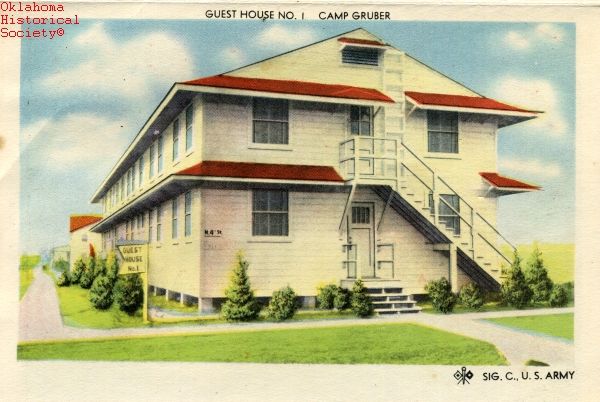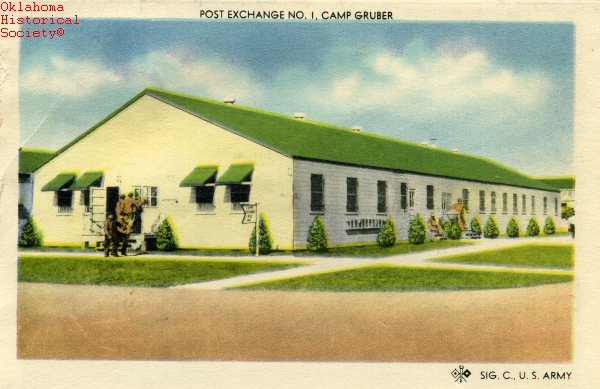
CAMP GRUBER.
War's outbreak in Europe in September 1939 prompted Pres. Franklin D. Roosevelt to declare a limited national emergency and improve military preparedness. By June 1940 Congressional measures had augmented the federal budget for construction of military training camps, and in 1941–42 eighty-four new camps were under construction or were approved. Because Oklahoma had an optimum location, climate, and natural resources and a large, available work force, the War Department considered the state a good site for pilot and infantry training fields. An infantry training camp was to be built near Braggs, in the Cookson Hills.
In 1935 and 1936 the U.S. Department of Agriculture had acquired nearly thirty thousand acres of farmland in eastern Oklahoma, of which 27,322.23 acres were already under federal stewardship. More land was acquired through condemnation. The Resettlement Administration relocated farmers who had owned or worked the property. In 1942 the entire area came under War Department control.
The Cookson Hills Project was designed to provide an infantry training center for the U.S. Army's Eighth Service Command. The camp ultimately encompassed between sixty thousand and seventy thousand acres, or approximately 109 square miles of land lying east of the Arkansas River and State Highway 10 in Muskogee and Cherokee counties. The closest community was Braggs, in Muskogee County; the nearest small metropolitan area was Muskogee, site of Hatbox Field and other defense facilities.
Construction on the Cookson Hills facility began in early January 1942 with the transfer of U.S. Army Corps of Engineers Southwestern Division personnel from Enid Air Field to establish a general headquarters in Muskogee and a field headquarters in Braggs. Soon engineers arrived and began the task of building a thirty-five thousand-troop facility. In February 1942 the camp was named "Gruber," after Brig. Gen. Edmund L. Gruber, longtime artillery officer at Fort Sill, Oklahoma.
Manhattan-Long Construction Company presented the winning bid. The contract called for the construction of 1,731 frame buildings, including barracks, hospitals, administration buildings, a bakery, chapels, a laundry, mess halls, recreation buildings, storage warehouses, theaters, guard houses, motor repair shops, officers' quarters, and miscellaneous buildings. A supply system would bring water from Greenleaf Lake to a storage reservoir adjacent to the camp; sewer, gas, and electrical systems and roads, grading, and drainage were built. The contractor also relocated State Highway 10 around the base. The army used preexisting buildings within the reservation boundary; a ranch house complex served as the post commander's billet. Construction proceeded through May 1942, and the first general order was issued on May 21.
The cantonment consisted of north-south and east-west streets in a U.S. Army modified triangular division layout. This part of the facility served as an area for barracks, for general administration, for engineer, ordnance, maintenance, and chemical warfare operations, and for medical and hospital services. North of the cantonment were grenade courts, bayonet courts, and obstacle courses, one of which strongly resembled the roads, fields, fences, and hedgerows that troops would later see in Europe. North of these were small-arms firing ranges. An area lying north and east of the training fields were armor and tank destroyer driving ranges and field, antiaircraft, and coastal artillery firing ranges. On the western shore of Greenleaf Lake lay a third use area with various training and recreation facilities, including Greenleaf Lodge, used as one of the cantonment's two officers' clubs.
During the course of World War II Camp Gruber provided training to infantry, field artillery, and tank destroyer units that went on to fight in Europe. Units of the Eighty-eighth Infantry "Blue Devil" Division trained at Camp Gruber. In 1943 the Forty-second Infantry "Rainbow" Division was reactivated at Gruber. In 1945 the Eighty-sixth Infantry "Blackhawk" Division was stationed there pending deactivation at the end of the war. Ultimately, more than 44,868 troops either served at or trained at the camp, which also employed four thousand civilian workers and incarcerated three thousand German prisoners of war.
On June 3, 1947, Camp Gruber was deactivated, and it soon became surplus property, with 63,920 acres placed under the authority of the War Assets Administration (WAA). In 1952 the General Services Administration assumed authority over 31,294.62 acres from the WAA, and between 1948 and 1952 the U.S. Army regained control of 32,626 acres. By 1953 virtually the entire 1942 reservation was in federal hands. During the 1950s and 1960s most of Camp Gruber's original buildings and facilities were removed or destroyed.
In 1967 the Oklahoma Military Department, Oklahoma Army National Guard (OKARNG), acquired 23,515 acres to establish Camp Gruber as a state-operated training area under a twenty-five year federal license from the Tulsa District of the U.S. Army Corps of Engineers. In 1973 and 1982 2,560 acres and 6,952 acres, respectively, were added, for a total of 33,027 acres. The present camp covers eighty-seven square miles. The cantonment area covers 620 acres, and ranges occupy 460 acres. At the end of the twentieth century Camp Gruber still served OKARNG as a training base for summer field exercises and for weekend training. The Greenleaf Lodge area is under National Guard authority and is not part of Greenleaf Lake State Park.








